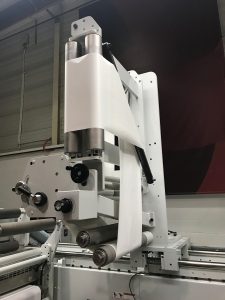Tension Issues With Turnbars? Not Anymore
Even the most experienced flexo operator has run into tension issues when using a turn bar. This commonly occurs when there is a difference of neutral axis or pacing radius shifts of the material.
The most common reason for this is the difference of neutral axis or pacing radius shifts of the material depending on which side is against the pacing rolls. This is due to the material being constructed of compounds that have different modulus of elasticity (stiffness) or not being homogeneous (consistent throughout its thickness).
Example:
Pressure-sensitive material has a face side and liner side. If you were to print this material with the face side up and then print the same material with the liner side up, measure the length of image, you would see a difference in length since the material paces differently in each of these conditions.
One of the most common observations is an application where the web slacks after the turnbar. The first action is raising the overall tension in the press. What this does is stretch/strain the material more so that the strain removal on the exit side caused by the lower pacing rate is not enough to reduce the web tension to an unacceptable level.
The most effective way to analyze problems of this nature is simple and only requires a standard tape measure. By using this method, press operators will identify the magnitude of the problem so that the appropriate action can be taken whether it is impression roll stepping or replacement or just running the proper tension.

The Process
Step 1: With the press in standard configuration without the turnbar, run the subject material through press face up (side A) and print one station.
Step 2: Run enough to allow the web tension to stabilize, remove 20 repeats. Measure the length from first print image to the last.
Step 3: Run the subject material though the press so that you can print on the liner side (side B) of the material. Note: Do not run though turn bar, simply run the roll around on unwind.
Step 4: Remove 20 repeats of material and measure the same length as performed on step 2.
Step 5: Calculate the pacing ratio by the equation: Side A ¸ Side B
How Can I Find This?
To find how much an impression roll may need to change we will look at a typical example where the web is slacking and our throw measurements show that Side A has a throw length of 240.0625 (96 tooth 12” or 1 ft repeat, 20 repeats). Side B has a throw length of 240” or theoretical.
Side A ¸ Side B X Impression roll diameter = C
C- Impression roll diameter = D
Example 240.0625″ ¸240″ x 3.9390″ = 3.940″
3.940” – 3.9390” = .001” Note: a positive number here indicates you need to add a .001” delta to the downstream or Side B or subtract this from your upstream rolls. On paper stocks with the modulus of elasticity 1.1 x 10^6 to 1.6 x 10^6 , 10” wide x .007” thick an increase of 20 to 30#s tension on the infeed side will eliminate the slack. However, most LP and non-servo 2200s may not have the potential to create this much additional tension and there may be slippage if the difference required is above 20#s. These situations require the impression rolls to be resized to accommodate the application. Combinations of tension increases and roll sizes can be made in an effort to maintain the performance of the press for normal non-turnbar applications. A rule of thumb is that for instances where the delta is above .001, a dedicated roll set before the turnbar may be needed and these rolls changed or bypassed for standard non-turnbar applications.
There are conditions where the throw measurements are essentially equal and you need to reduce the residual drag and you should check the items below.
4 Things to Consider
-Material should be rundown the center-line of press.
-Any holes that are not covered by material should be plugged to prevent too much pressure loss. As any rule of thumb any hole within 1″ of the web edge should be plugged.
-The material must be tightly wrapped around turn bars yet there must be sufficient pressure to allow air flow to create an air bearing to keep material separated from the bar so that it slides freely.
-Turn bars are not well suited for applications such as those utilizing porous materials, clingy plastics, foils, and thick board stocks.
Have a technical question about turnbars or other press upgrades and retrofits? Our dedicated team of support staff is available to answer them and work with you through any challenge you’re facing in the pressroom. Contact us here.